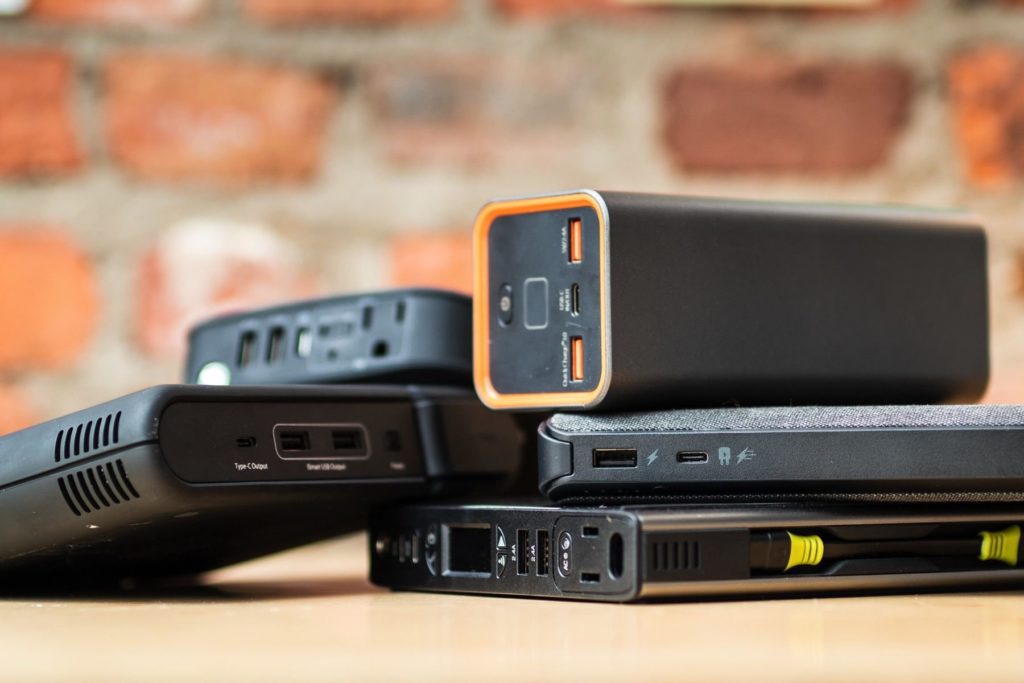
Five models, reviewed.
We spent 15 hours researching and 41 hours testing five top portable laptop chargers, and we found that the Mophie Powerstation AC is the best option if you want the ability to charge your computer and smaller devices while traveling, in an emergency, or whenever power outlets are out of reach. It can power laptops as robust as the 15-inch MacBook Pro, it’s compact and lightweight, and it charges via USB-C—an increasingly ubiquitous standard.
Mophie’s charger is the one we’d buy ourselves. It’s the smallest laptop charger we tested and one of the lightest. But it still performed well in our testing with more than 100 W of power output and enough capacity to bring a dead MacBook Air up to 81 percent charged, even during heavy use. It also has the best look and feel of any we tried—we really like how its slim, portable design and professional-looking fabric exterior is complemented by well-placed ports and a magnetic rubber flap protecting the AC output port. Plus, it’s made by a company we trust, and its 24-month warranty is as good as any we found.
Charging output: 100 W AC
Total capacity: 22,000 mAh, or roughly 81 Wh
Weight: 26.7 ounces (756 grams)
Dimensions: 7.5 by 4.5 by 1.1 inches (19 by 11.4 by 2.8 centimeters)
The RAVPower 27000 is the most affordable charger we tested and has power on par with the Mophie, but it feels less refined overall. The RAVPower feels much bulkier and has a more finicky interface, and its unwieldy charging cord and power brick are a chore to haul around. It’s also about a quarter of a pound heavier, and its grippy rubber finish collects fingerprints. These details aside, the RAVPower offers great performance for its price. Its maximum power output is just 4 watts lower than that of our pick, and it can fully recharge a MacBook Air once. It has the same output-port options as our pick too, plus an extra USB-A port. It’s the one we’d get if we needed one of these in a pinch and the Mophie wasn’t available.
Charging output: 70 W AC
Total capacity: 27,000 mAh, or roughly 100 Wh
Weight: 29.9 ounces (848 grams)
Dimensions: 6.9 by 1.4 by 5.3 inches (17.5 by 13.5 by 3.6 centimeters)
Why you should trust us
Before working at Wirecutter, I was a science writer and fact checker for over four years. At Wirecutter, I’ve reported on the best USB-C cables, portable solar battery packs, and more. I spent 56 hours researching and testing portable laptop chargers for this guide alone. The editor of this guide, Mark Smirniotis, has written about batteries and charging for Wirecutter for over three years.
We also consulted with Lee Johnson, an electrical engineer with more than 10 years of experience designing and testing electronics. Sterling Robison, engineering supervisor at Goal Zero, provided some helpful context about the product-development side of the industry.
Who this is for
Portable laptop chargers aren’t just for laptops. They are power banks with AC outlets that can provide on-the-go power for a long list of devices—from phones and tablets to breast pumps and baby monitors. But since most people who buy these are mainly looking to charge their laptop, we wrote this guide with them in mind. (If you really only need USB-C and USB-A ports, our favorite USB-C power banks are powerful enough to charge a MacBook Pro, Dell XPS 13, and other laptops that charge via USB-C.)
If you work remotely, you may not have consistent access to a wall outlet. Competition for outlets can be stiff at coffee shops, libraries, and coworking spaces. And if you have a long commute, travel frequently, or regularly attend off-site meetings and conferences, an alternative source of power like one of our picks can relieve charge anxiety. This is especially true if your laptop is near the end of its lifespan or if you run a lot of apps and programs at once.
Even someone who is rarely away from their desk might want a portable laptop charger in case of a blackout or other emergency. Ready.govrecommends keeping “a back-up power source on hand to recharge your phone so that you can stay connected even during an extended power outage.” You could always use one of our favorite USB-A or USB-C power banks for this, but a portable laptop charger gives you more types of output ports and, in most cases, more power.
This guide doesn’t cover larger portable power stations, which weigh as much as 50 pounds and can output hundreds of watts—the type of thing you’d want for off-grid living, car camping, or fieldwork. We’re currently testing power banks like this for a new guide.
How we picked
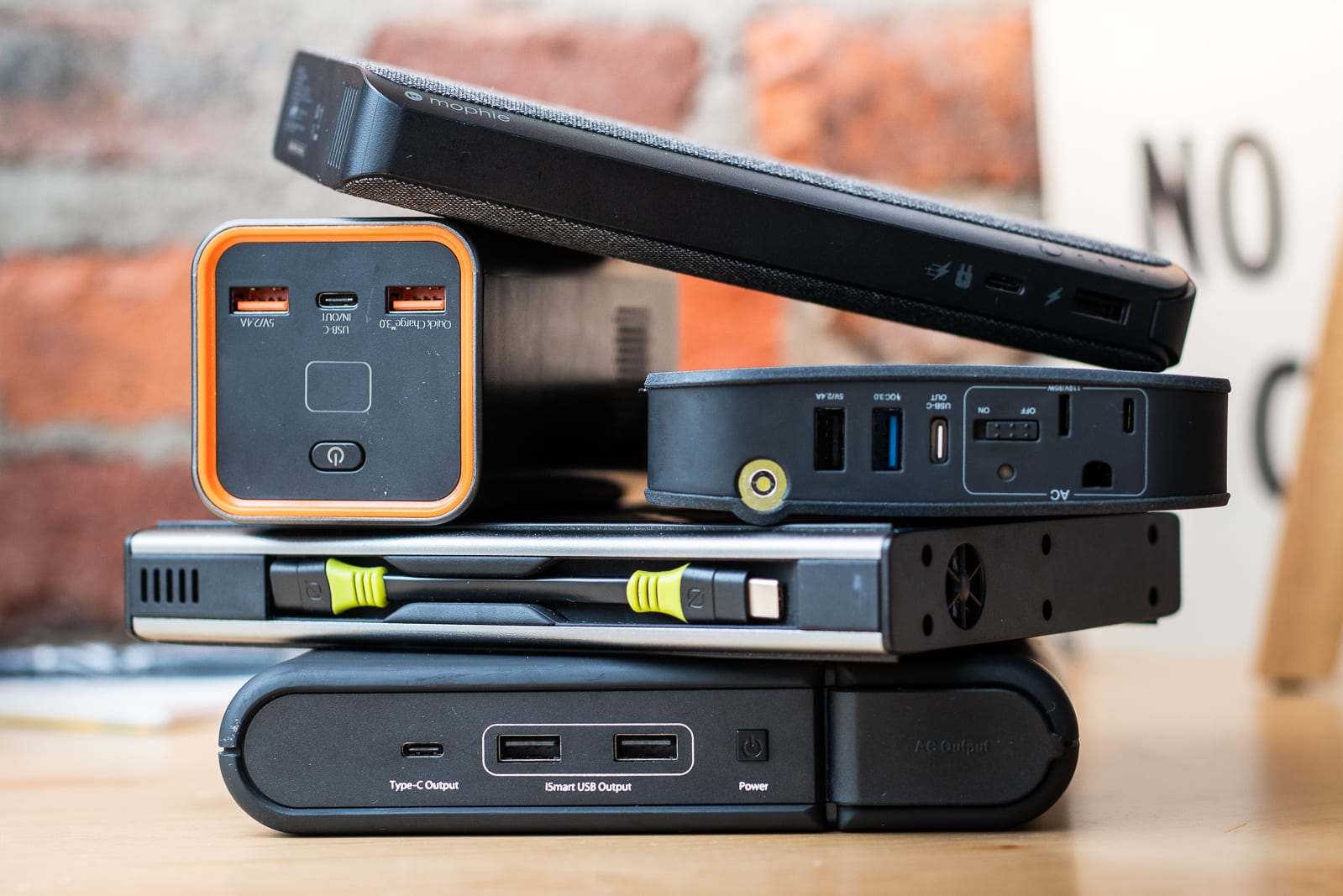
Photo: Sarah Kobos
To find the most popular power banks that include AC outlets, we scanned the top results on Amazon, Google Shopping, and major retailers like Target and REI. We also considered models recommended by news outlets like the Verge, Popular Science, Forbes, and Lifewire.
We catalogued a range of features for each model we found, and narrowed our search with these requirements:
- An output rating of at least 65 watts: Most MacBooks (except for the 15-inch MacBook Pro) need about 60 watts to charge at full speed, so we set our minimum limit at 65 watts just to be safe.
- Capacity between 60 and 100 watt-hours: Per FAA and TSA regulations, you need airline approval to transport “spare” or “loose” lithium-ion batteries exceeding 100 watt-hours. Even then, you are limited to two batteries and can only bring them in a carry-on bag; lithium-ion batteries of all capacities are banned from checked luggage. Since some people like to work (or watch movies) on their laptop on long flights, we capped our capacity limit at 100 watt-hours. On the lower end, we set our minimum at 60 watt-hours because that’s equivalent to running a 60-watt device (like a 13-inch MacBook Pro) for one hour; most of the models we considered are rated for 75 watt-hours or more.
- Light and compact enough to fit in a briefcase, backpack, or laptop bag: Although we didn’t set strict size and weight requirements, we wanted something small and lightweight so it would as easy to bring to a coffee shop as it would be take on a plane. We didn’t end up testing anything heavier than 2 pounds (like a hardcover novel) or bigger than 60 inches in volume (about the size of a standard brick).
- At least a one-year warranty and readily available customer support: If you’re spending upwards of $300 on something and relying on it in tight situations, you want to know that the manufacturer is reachable in case something goes wrong.
- At least one USB-C port: USB-C ports are starting to replace older USB-A ports, in part because the new standard is capable of transmitting roughly eight times the amount of power—up to 100 W for compatible devices. Since a portable laptop charger is an expensive investment, we think a fast-charging USB-C connection is key to future-proofing the purchase so it still works great with the new devices you’re likely to get in coming years.
- At least one USB-A port with at least 12-watt charging per port: Even though USB-C is becoming more common, most of us still have standard USB-A charging cables, so we insisted that our picks had at least one USB-A port—handy for charging smaller devices like smartphones, e-readers, and wireless headphones.
- At least one AC outlet compatible with three-prong plugs: Even though not all power cords have the third ground prong, power cords with the brick in the middle generally require it since it’s safer. A three-prong outlet on a portable laptop charger makes it much more versatile since it can power any device, not just ones with two-prong cords.
- A cost of no more than $300: Based on the range of prices we saw, this is what we think someone would reasonably want to spend on a work-related expense.
This left us with the following five models to test:
- Goal Zero Sherpa 100 AC
- Jackery PowerBar 23200
- Mophie Powerstation AC
- Naztech Volt Power Station AC Outlet 14149
- RAVPower 27000
How we tested
Over the course of a week, we spent 41 hours testing all five portable laptop chargers. As the writer for this guide, I got to know them better than some people I’ve dated. We tested the performance of each charger in key areas, including:
- How many times each charger could recharge a laptop: To test the useful capacity of each charger, we started with a fully dead 2015 13-inch MacBook Air and a fully charged portable laptop charger. Once we plugged the MacBook Air’s wall charger into the AC port of the portable charger and it could power on, we turned the screen brightness all the way up and started playing a loop of Harry Potter movies on iTunes. We let it run until the portable charger died or the laptop became fully charged—whichever came first. If the portable charger died first, we recorded how much the laptop had been charged at that point. If the laptop reached 100 percent before the portable charger died, we shut everything down, fully drained the laptop by streaming hours-long 4K videos on YouTube, then repeated the test with the partially charged portable charger to get a combined number of recharges greater than 100 percent.
- Noise: If you turn on your portable charger in a library or quiet meeting, you don’t want the fans or electrical whine to be so loud as to distract everyone in the room. To test loudness, we placed an RC Professional Decibel Meter next to the cooling fan of each portable charger and used an array of halogen light bulbs to make sure the power draw was high enough for the cooling fans to kick in. We recorded the maximum sound level of each, and we also made subjective notes about which chargers made more noticeable—or more annoying—sounds.
- Maximum power output: If you try to power something that needs more than a portable power outlet can provide, the whole unit will shut down to protect itself. To test the maximum power output of each model, we connected each one to a Kill A Watt power meter and an array of light-bulb sockets. We powered 20-watt halogen bulbs one by one until they overloaded the portable charger and caused it to shut down, then recorded the maximum wattage reading on the power meter.
- Ability to charge a 15-inch MacBook: To make sure all of the chargers could power a large, high-powered laptop, we connected them to a 15-inch MacBook Pro that normally uses an 87-watt power adapter and checked the Mac System Report to make sure it wasn’t struggling to get enough power.
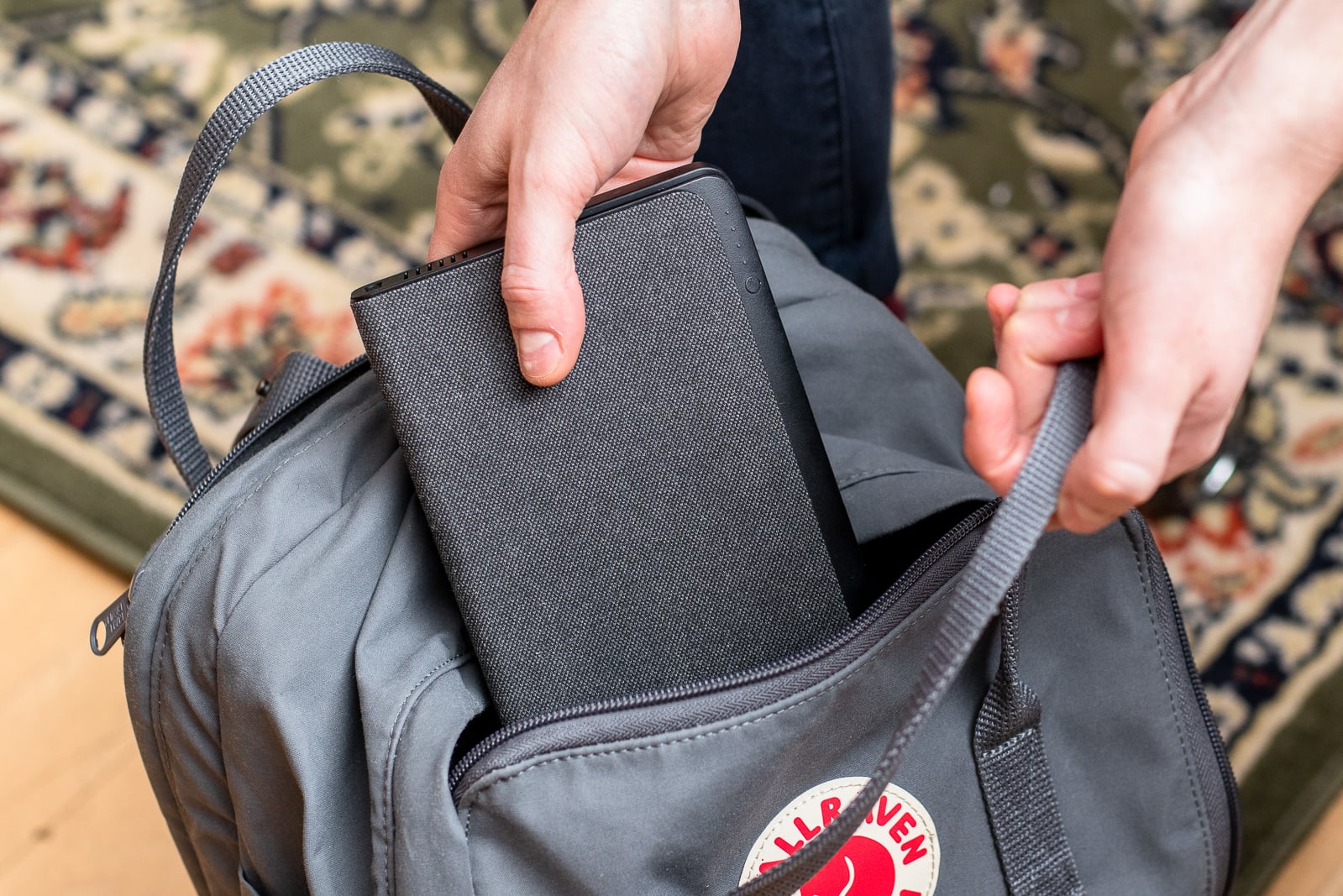
- Look and feel: We picked them up, stuffed them into a crammed backpack, and carried them around throughout our testing period to see how well they’d fit into our everyday lives.
- Electrical and inverter quality: We used a BitScope oscilloscope to visualize the electrical waveforms of each charger and make relative comparisons with the help of electrical engineer Lee Johnson. Every charger we tested contains a modified sine-wave inverter that converts the battery’s DC, or direct current, power into AC, or alternating current, power—which is needed to charge most devices. The best modified sine-wave inverters can produce waveforms that are clear and well-defined enough to be used by most devices with a household plug, albeit choppier than the pure sine-wave power that comes from your home outlets. A smoother, clearer waveform represents a consistent flow of power that will allow your devices to run efficiently.
Our pick: Mophie Powerstation AC
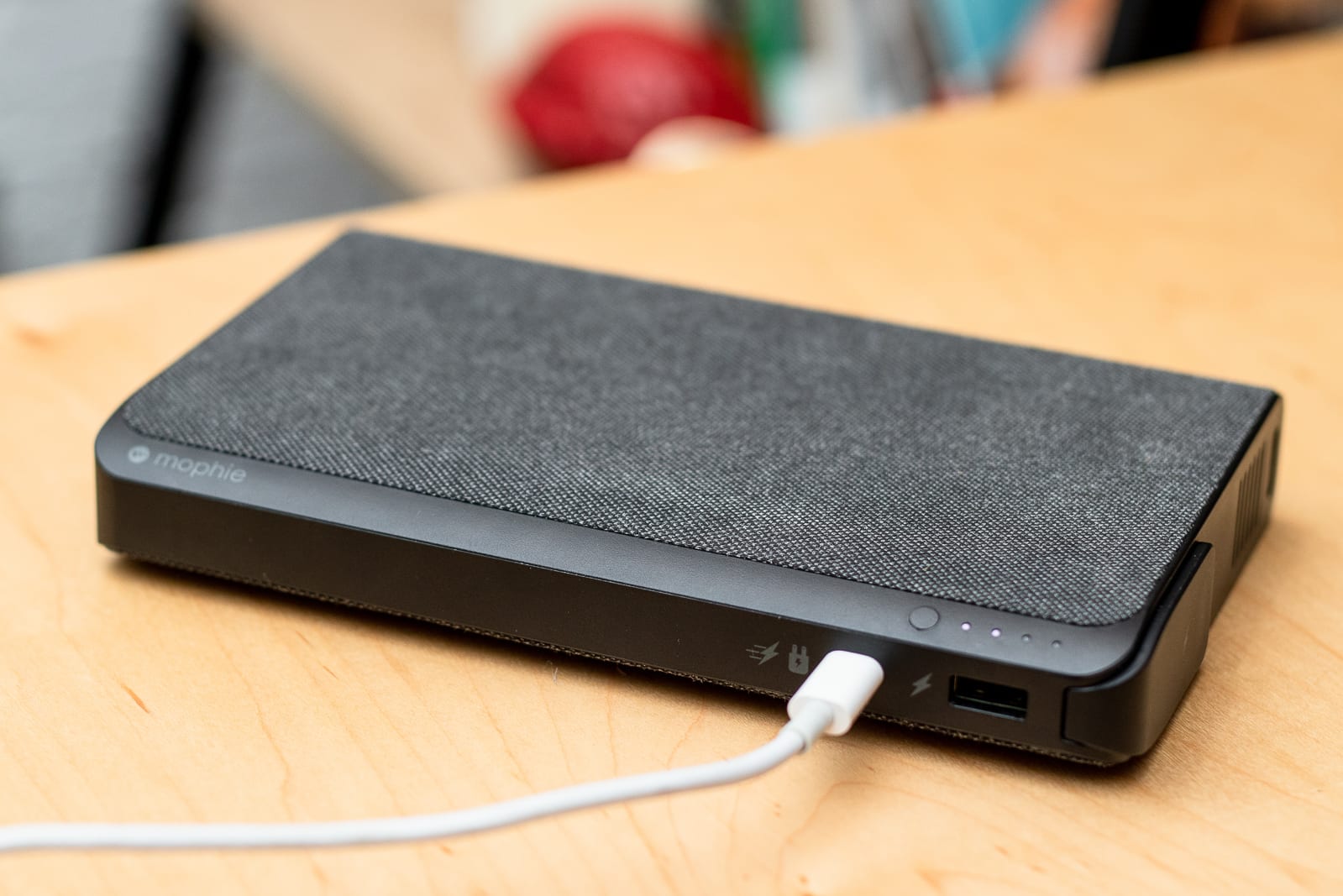
Mophie’s Powerstation AC is the portable laptop charger we’d buy ourselves. With enough power output to keep a 15-inch laptop running, it charged our MacBook Air to nearly full even with the screen brightness up and video playing. But even with the extra power, it’s the smallest we tested and one of the lightest, too. It’s stylish and professional-looking, yet well-protected from dings and scratches, and its slim shape makes it easy to slip into a backpack pocket or briefcase. Plus, it has some surprisingly useful features—from appropriately spaced ports that make it easy to plug in multiple devices at once to a protective rubber flap covering the AC outlet and keeping out lint and crumbs.
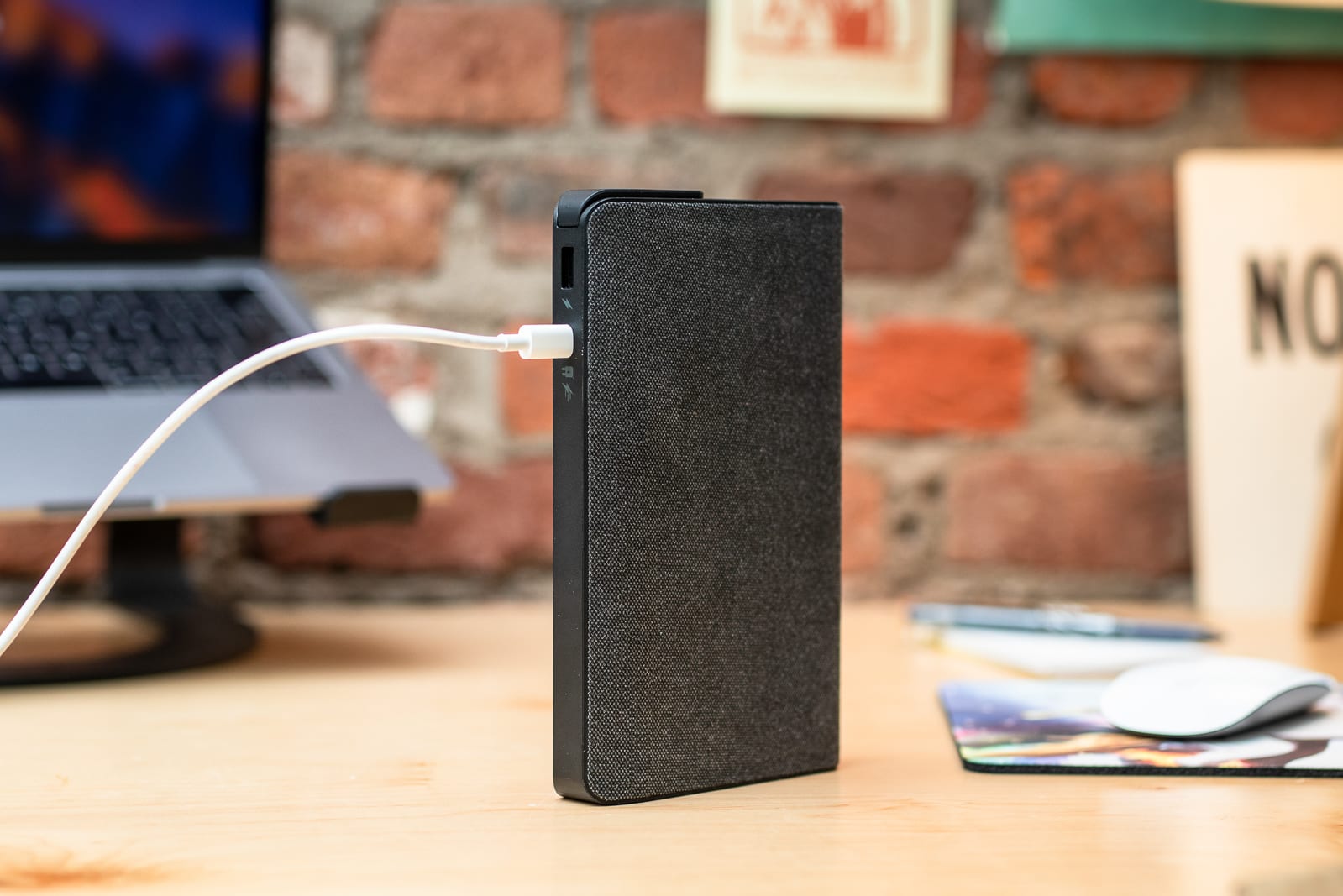
In our peak power tests, The Powerstation AC got up to 123 watts before shutting down—outperforming all but one model, the Goal Zero Sherpa 100 AC. With that much power, the Powerstation can charge small devices like a phone, wireless headphone, or vaporizer, or larger ones like a high-powered laptop.
When we charged an empty MacBook Air, the Powerstation AC brought it up to 81 percent with the screen at full brightness, Wi-Fi on, and an HD movie streaming. That may not seem ideal, but even the highest-capacity charger we tested—our runner-up pick from RAVPower—only charged the laptop fully once under such conditions, with a little reserve left. When we considered that a power bank like this is primarily used to provide backup power between access to wall outlets, we felt that the extra portability of the Powerstation AC was worth the slightly lower capacity.
The Powerstation measures 4.5 inches wide, 7.5 inches tall, and 1.1 inches thick (about the size of a paperback novel) and it weighs 1.7 pounds, which is a few ounces heavier than the newest iPads. It’s flatter and smaller overall than the Jackery, about three ounces lighter than the RAVPower. It’s encased in a dark gray, twill fabric that looks and feels nicer than plastic. The fabric seems like it would improve durability, too, by protecting the exterior from cracks and scratches.
Of all the chargers we tested, the Powerstation is one of the easiest to use. Its interface is straightforward: You hold down the power button until a little green light turns on to boot up the AC power, and you hold it down again to turn it off. You can also press a smaller button in the corner that contains the three ports—USB-A, USB-C, and AC—to illuminate a row of lights showing how much juice the charger has left.
We especially liked the rubber flap over the AC port, which prevents dust and other debris from getting into the port when getting jostled about in a backpack or laptop bag. A magnet keeps the flap securely in place, which is a nice touch that we didn’t see in any of the other models. The other ports are positioned such that you can fit a fat, three-prong AC plug on one side, plus your USB-C and USB-A cables around the corner, without interference—only the Jackery PowerBar had a layout as generous.

For a modified sine-wave inverter, the Mophie produced a relatively smooth and consistent waveform in our oscilloscope testing. Lee Johnson, the electrical engineer who analyzed the waveforms for us, determined that all of the models performed similarly.

The Powerstation is made by a brand we trust (Mophie has been making power accessories for over a decade) with reliable customer support (we called the main number anonymously and got through to someone within seconds who was happy to answer our questions about the Powerstation), and its two-year warranty is as long as any we found. Plus, it’s widely available from a variety of retailers.
Flaws but not dealbreakers
The Mophie Powerstation AC doesn’t include a wall charger but comes with two USB cables—one of them USB-C–to–USB-C, the other USB-A–to–USB-C. We love that USB charging means you don’t need to carry a bulky wall charger and power brick—any USB port you have handy for other devices can do double duty and charge the Powerstation AC. But if you only have USB-A ports, they might charge painfully slow. If you’re looking for a new USB-C charger for the fastest recharge times, we’d get the Anker PowerPort II PD because it’s small and portable, fairly inexpensive, and allows you to charge at top USB Power Delivery speeds.
While the Powerstation met our minimum requirements (offering at least one USB-A and USB-C port), it was the only model we tested that had one, not two, USB-A ports. It would be great if the Powerstation had more than one of each port. Its cooling fan was the second-noisiest we tested, but the tone wasn’t as bothersome in a quiet room as some others.
Budget pick: RAVPower 27000
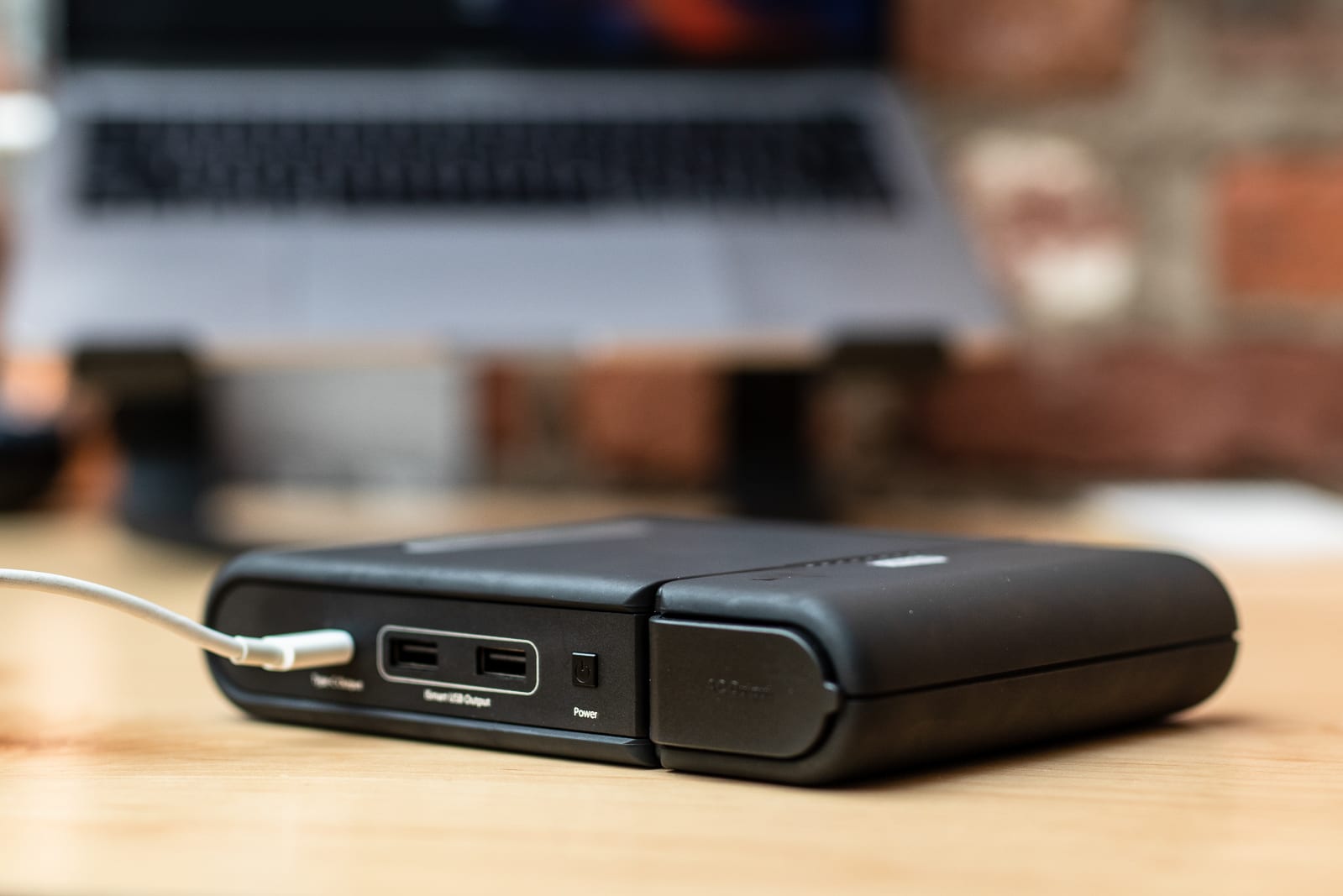
If you don’t want to spend quite as much—and you don’t mind a bulkier, not-so-sleek charger—the RAVPower 27000 is a good option. It has almost the same power output and capacity as our top pick, but it feels a lot larger, and the clunky wall charger and power brick make it cumbersome to pack up for trips. Even though it offers similar utility, we found our top pick was a better experience overall that is worth the price.
The RAVPower’s peak-power performance, 119 watts, was roughly the same as our main pick’s maximum of 123 watts. It was able to charge small devices as well a 15-inch MacBook Pro without a problem. When we tested its capacity, it was able to charge a depleted MacBook Air about once from zero to 100 percent with its screen at max brightness while streaming an HD video.
That was the highest capacity of any we tested, besting the competition by anywhere from 3 percent (basically a rounding error) to about 20 percent.
It’s a little heavier than our main pick—1.9 pounds to the Mophie’s 1.7 pounds. But the larger size and a little bit of extra weight makes it feel much clunkier than our top pick, and it’s just not as stylish overall: The gap splitting the charger into two sections is an odd, visually jarring design choice, as it doesn’t seem to serve a purpose. The rubbery exterior of the RAVPower looks good and feels pleasantly grippy and durable, but it does tend to show fingerprints and oils easily.
Even when the RAVPower’s cooling fan kicked in, it was one of the quietest models we tested. It barely moved the needle on our decibel meter, and we wouldn’t be embarrassed to turn it on in a meeting, lecture hall, or some other place where a noisy fan would be distracting.

The RAVPower has a USB-C port, an AC port, and two 2.4-amp USB-A ports (one more than our main pick), giving you plenty of charging options. You might have trouble using all of them at once, though, especially if your plugs are wide or oddly shaped, since all of the ports are on the same side.
Its warranty (18 months) is slightly shorter than Mophie’s, but RAVPower is a brand we trust in terms of build quality, customer support, and availability.
The RAVPower 27000 has a few major downsides. Our biggest complaint is its size. It’s the second-biggest model we tested (after the Naztech) at 5.31 by 6.89 by 1.38 inches, plus its AC/DC charger is the most unwieldy. It’s nice that it comes with a zip-up hardshell case, but the whole setup is just not as portable as our main pick. Anyone carefully packing their bag to commute on public transit or keeping track of every cubic inch of carry-on space for regular business trips will have a much easier time with our top pick.
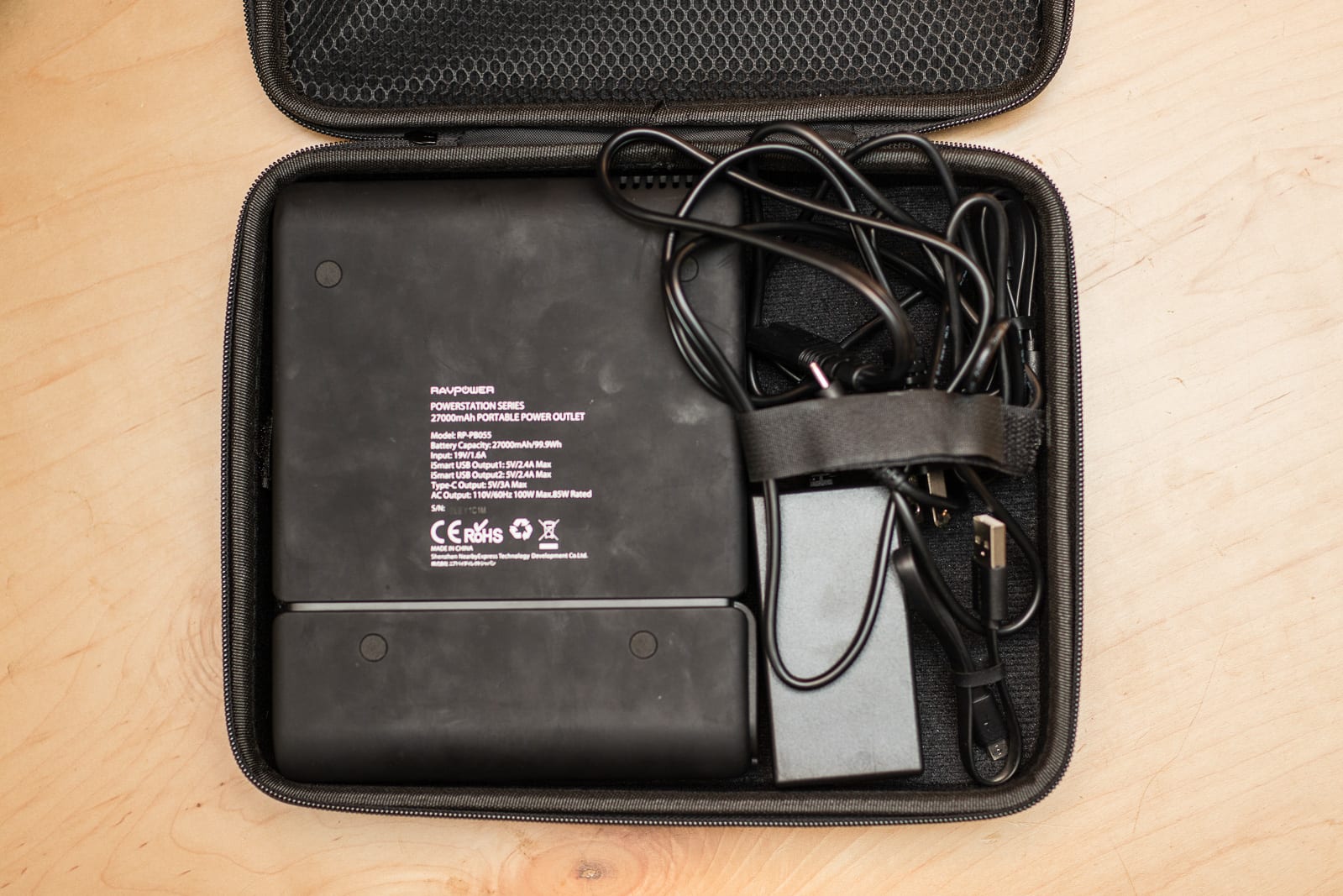
In addition to its extra bulk, the RAVPower offers a slightly worse user experience than our main pick. To get the AC output to turn on, you have to hold down the power button for several seconds, and it turns off quickly if not plugged into something.
The RAVPower comes with two USB-A–to–Micro-USB cables, which is nice, but it’s not much of a bonus. If you’re someone who needs to charge Micro-USB devices, you probably already have plenty of those lying around.
What to look forward to
We are currently testing five portable power stations—the Yeti 400, Yeti 1000, and Yeti 1400 with WiFi from Goal Zero, the EcoFlow River, and the Suaoki G500—for people who need even more power than the ones in this guide can provide. We’ll link to our new guide here as soon as it’s ready.
The competition
ChargeTech Portable AC Outlet: This was our runner-up pick in a former version of this guide, but we decided not to consider it for this round of testing because it doesn’t have a USB-C port and it has a low wattage rating (85 watts) for the price.
Goal Zero Sherpa 100 AC: This charger is fairly compact, is enjoyable to use, and has an informative OLED screen. It had the highest peak-power output (160 watts) in our testing, and it charged the MacBook Air 0.95 times on a single charge. But it’s also the most expensive model we tested, retailing for around $300 at the time of this writing. It’s also the heaviest (2 pounds, tied with the Naztech) and noisiest model we tested, and its one-year warranty is the shortest we’ve seen.
Jackery PowerBar 23200: Our former top pick, the Jackery PowerBar 20800, is being discontinued and replaced with the PowerBar 23200. It’s the lightest model we tested (1.5 pounds), its two-year warranty is as good as any we’ve seen, and it’s one of the most inexpensive models we tested. The Jackery looks nice and seems well-built, but its brick-shaped design isn’t as sleek or portable as the others—it’s a lot tougher to slip into a briefcase than the book-shaped ones, and multiple Wirecutter staffers said they’d prefer a slimmer design. Also, its fan wasn’t the absolute loudest we tested, but unlike the others, it becomes audible as soon as you turn on the AC output and was much more distracting in a quiet room.
Naztech Volt Power Station AC Outlet 14149: This charger has one of the best warranties (2 years) and costs the least of those we tested. It shares some aspects of both our picks, with a clean, simple look and good capacity. However, it’s the heaviest charger we tested, along with the Goal Zero, at 2 pounds. It’s also the biggest, measuring 5.3 by 1.4 by 6.9 inches, and its AC/DC charger is a bit bulky. It had the lowest peak-power output (95.1 watts) in our testing, and it’s one of the most finicky ones to control when it comes to turning the power—or even the flashlight—on and off. Lastly, we’ve had little experience with Naztech and the Volt brand, and when we contacted the company’s customer support, it took 17 days to get a response, which doesn’t bode well for customers if something goes wrong.


